
Culp's Hill
Encyclopedia
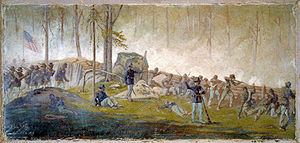
Culps Hill is a Battle of Gettysburg
Battle of Gettysburg
The Battle of Gettysburg , was fought July 1–3, 1863, in and around the town of Gettysburg, Pennsylvania. The battle with the largest number of casualties in the American Civil War, it is often described as the war's turning point. Union Maj. Gen. George Gordon Meade's Army of the Potomac...
landform 0.75 mi (1.2 km) south of Gettysburg, Pennsylvania
Gettysburg, Pennsylvania
Gettysburg is a borough that is the county seat, part of the Gettysburg Battlefield, and the eponym for the 1863 Battle of Gettysburg. The town hosts visitors to the Gettysburg National Military Park and has 3 institutions of higher learning: Lutheran Theological Seminary, Gettysburg College, and...
, with a heavily wooded summit of 630 ft (192 m). The east slope is to Rock Creek (Monocacy River), 160 feet (50 m) lower in elevation, and the west slope is to a saddle with Stevens Knoll
Stevens Knoll
Stevens Knoll is a hill named for Captain Greenleaf T. Stevens and adjacent to Culp's Hill on the Gettysburg Battlefield that was a Battle of Gettysburg emplacement of Union artillery....
(formerly McKnight's Hill) with a summit 100 ft (30.5 m) lower than the Culps Hill summit. The hill was owned in 1863 by farmer Henry Culp and was publicized as "Culp's Hill" by October 31, 1865.
During the Battle of Gettysburg
Battle of Gettysburg
The Battle of Gettysburg , was fought July 1–3, 1863, in and around the town of Gettysburg, Pennsylvania. The battle with the largest number of casualties in the American Civil War, it is often described as the war's turning point. Union Maj. Gen. George Gordon Meade's Army of the Potomac...
, July 1–3, 1863, Culps Hill was a critical part of the Union army
Union Army
The Union Army was the land force that fought for the Union during the American Civil War. It was also known as the Federal Army, the U.S. Army, the Northern Army and the National Army...
defensive line, the right flank, or "barbed" portion of what is described as the "fish-hook" line. Holding the hill was by itself unimportant because its heavily wooded sides made it unsuitable for artillery placement, but its loss would have been catastrophic to the Union army
Union Army
The Union Army was the land force that fought for the Union during the American Civil War. It was also known as the Federal Army, the U.S. Army, the Northern Army and the National Army...
. It dominated Cemetery Hill and the Baltimore Pike, the latter being critical for keeping the Union army supplied and for blocking any Confederate
Confederate States Army
The Confederate States Army was the army of the Confederate States of America while the Confederacy existed during the American Civil War. On February 8, 1861, delegates from the seven Deep South states which had already declared their secession from the United States of America adopted the...
advance on Baltimore or Washington, D.C.
Washington, D.C.
Washington, D.C., formally the District of Columbia and commonly referred to as Washington, "the District", or simply D.C., is the capital of the United States. On July 16, 1790, the United States Congress approved the creation of a permanent national capital as permitted by the U.S. Constitution....
Battle of Gettysburg, First Day
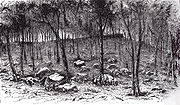
I Corps (ACW)
I Corps was the designation of three different corps-sized units in the Union Army during the American Civil War. The units served in the following armies:...
and XI Corps
XI Corps (ACW)
The XI Corps was a corps of the Union Army during the American Civil War, best remembered for its involvement in the battles of Chancellorsville and Gettysburg in 1863.-Formation and the Valley Campaign:...
, along with neighboring Cemetery Hill, as a rallying point from the retreat following the Confederate victory that day north and west of town. Lt. Gen. Richard S. Ewell
Richard S. Ewell
Richard Stoddert Ewell was a career United States Army officer and a Confederate general during the American Civil War. He achieved fame as a senior commander under Stonewall Jackson and Robert E...
had discretionary orders to seize the heights south of town, and he believed that Culp's Hill was unoccupied and therefore a good target, one that would make the Union position on Cemetery Hill untenable. His third division, under Maj. Gen. Edward "Allegheny" Johnson
Edward Johnson (general)
Edward Johnson , also known as Allegheny Johnson , was a United States Army officer and a Confederate general in the American Civil War.-Early life:...
, had just arrived on the battlefield, and Johnson was ordered to take the hill if he had not already done so.
Johnson did not take Culp's Hill. He sent a small party to reconnoiter, and they encountered the 7th Indiana Infantry of the I Corps, part of Brig. Gen. James S. Wadsworth
James S. Wadsworth
James Samuel Wadsworth was a philanthropist, politician, and a Union general in the American Civil War. He was killed in battle during the Battle of the Wilderness of 1864.-Early years:...
's division, which had been in the rear guarding the corps trains and was now linked up with the Iron Brigade
Iron Brigade
The Iron Brigade, also known as the Iron Brigade of the West or the Black Hat Brigade, was an infantry brigade in the Union Army of the Potomac during the American Civil War. Although it fought entirely in the Eastern Theater, it was composed of regiments from Western states...
, digging in following their fierce battle on Seminary Ridge
Seminary Ridge
Seminary Ridge is a dendritic ridge which was an area of Battle of Gettysburg engagements during the American Civil War and of military installations during World War II.-Geography:...
. Johnson's party was taken by surprise and almost taken prisoner before fleeing.
Ewell's failure to take Culp's Hill or Cemetery Hill
Cemetery Hill
Cemetery Hill is a Gettysburg Battlefield landform which had 1863 military engagements each day of the July 1–3 Battle of Gettysburg. The northernmost part of the Army of the Potomac defensive "fish-hook" line, the hill is gently sloped and provided a site for American Civil War artillery...
that evening is considered one of the great missed opportunities of the battle. Another reason for his reluctance to proceed was intelligence that Union troops were approaching from the east on the Hanover Road. This was the vanguard of the XII Corps
XII Corps (ACW)
The XII Corps was a corps of the Union Army during the American Civil War.The corps was formed by U.S. War Department General Order of March 13, 1862, under which the corps organization of the Army of the Potomac was first created. By that order, five different corps were constituted: one of...
under Maj. Gen. Henry W. Slocum. If those troops had arrived at the wrong time, Ewell's flank would have been turned.
Second day
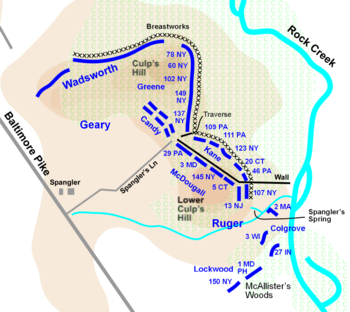
George S. Greene
George Sears Greene was a civil engineer and a Union general during the American Civil War. He was part of the Greene family of Rhode Island, which had a distinguished military record for the United States. His greatest contribution during the war was his defense of the Union right flank at Culp's...
, who at 62 was the oldest Union general on the field, was a brigade commander in the division of Maj. Gen. John W. Geary
John W. Geary
John White Geary was an American lawyer, politician, Freemason, and a Union general in the American Civil War...
. As a civil engineer
Civil engineer
A civil engineer is a person who practices civil engineering; the application of planning, designing, constructing, maintaining, and operating infrastructures while protecting the public and environmental health, as well as improving existing infrastructures that have been neglected.Originally, a...
before the war, he had a natural understanding of the value of defensive works. His division and corps commanders did not believe they would be stationed at Culp's Hill very long and did not share his enthusiasm for constructing breastworks, but they did not oppose his efforts. He set his troops to the task of felling trees and collecting rocks and earth to create very effective defensive positions.
The Union defensive positions on July 2 began in the north with artillery batteries on Stevens's Knoll, followed by Wadsworth's division of the I Corps, Greene's New York brigade in positions running north to south on the upper slope, and the brigade of Brig. Gen. Thomas L. Kane
Thomas L. Kane
Thomas Leiper Kane was an American attorney, abolitionist, and military officer who was influential in the western migration of the Latter-day Saint movement and served as a Union Army colonel and general of volunteers in the American Civil War...
connecting to Greene's line behind breastworks on the lower slope. Behind these front lines were, from left to right, the brigades of Col. Charles Candy
Charles Candy
Charles Candy was a career soldier in the United States Army who served as an officer in the volunteer Union Army during the American Civil War...
, Col. Archibald L. McDougall
Archibald L. McDougall
Archibald L. McDougall was an officer in the Union Army during the American Civil War who commanded the 123rd New York Infantry early in the war and subsequently led a brigade at the Battle of Gettysburg.-Biography:...
, Col. Silas Colgrove, and Brig. Gen. Henry H. Lockwood, extending past Spangler's Spring and through McAllister's Woods. (The latter three brigades were from the XII Corps division of Brig. Gen. Thomas H. Ruger
Thomas H. Ruger
Thomas Howard Ruger was an American soldier and lawyer who served as a Union general in the American Civil War. After the war, he was a superintendent of the United States Military Academy at West Point, New York....
, who was filling in for Brig. Gen. Alpheus S. Williams
Alpheus S. Williams
Alpheus Starkey Williams was a lawyer, judge, journalist, U.S. Congressman, and a Union general in the American Civil War.-Early life:...
, temporarily in corps command.)
That morning, Confederate General Robert E. Lee
Robert E. Lee
Robert Edward Lee was a career military officer who is best known for having commanded the Confederate Army of Northern Virginia in the American Civil War....
ordered attacks on both ends of the Union line. Lt. Gen. James Longstreet
James Longstreet
James Longstreet was one of the foremost Confederate generals of the American Civil War and the principal subordinate to General Robert E. Lee, who called him his "Old War Horse." He served under Lee as a corps commander for many of the famous battles fought by the Army of Northern Virginia in the...
attacked with his First Corps
First Corps, Army of Northern Virginia
The First Corps, Army of Northern Virginia was a military unit fighting for the Confederate States of America in the American Civil War. It was formed in early 1861 and served until the spring of 1865, mostly in the Eastern Theater. The corps was commanded by James Longstreet for much of its...
on the Union left (Little Round Top
Little Round Top
Little Round Top is the smaller of two rocky hills south of Gettysburg, Pennsylvania. It was the site of an unsuccessful assault by Confederate troops against the Union left flank on July 2, 1863, the second day of the Battle of Gettysburg....
, Devil's Den
Devil's Den
Devils Den is a boulder-strewn Gettysburg Battlefield hill used by artillery and infantry during the 1863 Battle of Gettysburg, Second Day...
, the Wheatfield). Ewell and the Second Corps
Second Corps, Army of Northern Virginia
The Second Corps of the Army of Northern Virginia was a military organization within the Confederate Army of Northern Virginia during much of the American Civil War. It was officially created and named following the Battle of Sharpsburg in 1862, but comprised units in a corps organization for quite...
were assigned the mission of launching a simultaneous demonstration against the Union right, a minor attack that was intended to distract and pin down the Union defenders against Longstreet. Ewell was to exploit any success his demonstration might achieve by following up with a full-scale attack at his discretion.
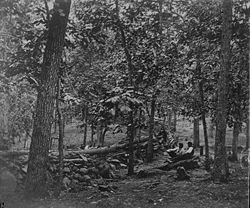
Army of the Potomac
The Army of the Potomac was the major Union Army in the Eastern Theater of the American Civil War.-History:The Army of the Potomac was created in 1861, but was then only the size of a corps . Its nucleus was called the Army of Northeastern Virginia, under Brig. Gen...
commander, Maj. Gen. George G. Meade. Meade was occupied with the fierce fighting on his left flank and was scrambling to send as many reinforcements as possible. He ordered Slocum to send the XII Corps in support. It is unclear whether he ordered the entire corps or instructed Slocum to leave one brigade behind, but the latter is what Slocum did, and Greene's brigade was left with the sole responsibility for defending Culp's Hill.
Greene extended his line to the right to cover part of the lower slope, but his 1,400 men would be dangerously overextended if a Confederate attack came. They were only able to form a single battle line, without reserves. Only three of the five brigades of Union troops that were dispatched from the hill saw combat. The remainder of Geary's division marched down the Baltimore Pike and missed a key right hand turn. By the time they realized where they were, the crisis on the Union left flank and center had subsided.
Around 7 p.m., as dusk began to fall, and the Confederate assaults on the Union left and center were slowing, Ewell chose to begin his main infantry assault. He sent three brigades (4,700 men) from the division of Maj. Gen. Edward "Allegheny" Johnson across Rock Creek and up the eastern slope of Culp's Hill. The brigades were, from left to right, those of Brig. Gen. George H. Steuart, Col. Jesse M. Williams
Jesse M. Williams
Jesse Milton Williams commanded a Louisiana regiment in the American Civil War. He briefly held brigade command at the Battle of Gettysburg. Prior to the Civil War, Williams attended the University of Alabama and lived in Mansfield, Louisiana.The 2nd Louisiana Infantry was organized in 1861,...
(Nicholl's Brigade), and Brig. Gen. John M. Jones
John M. Jones
John Marshall Jones was a brigadier general in the Confederate States Army during the American Civil War. He fought at the Battle of Gettysburg and was killed in action at the Battle of the Wilderness.-Early life:...
. The Stonewall Brigade
Stonewall Brigade
The Stonewall Brigade of the Confederate Army during the American Civil War, was a famous combat unit in United States military history. It was trained and first led by General Thomas J. "Stonewall" Jackson, a professor from Virginia Military Institute...
, under Brig. Gen. James A. Walker
James A. Walker
James Alexander Walker was a Virginia lawyer, politician, and Confederate general during the American Civil War, later serving as a United States Congressman for two terms...
, was occupied with Union cavalry on Brinkerhoff's Ridge to the rear.
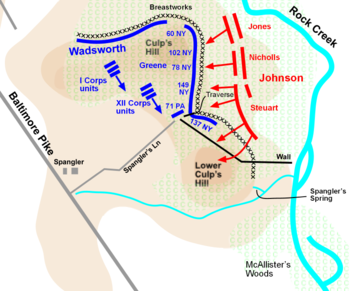
Oliver O. Howard
Oliver Otis Howard was a career United States Army officer and a Union general in the American Civil War...
on Cemetery Hill was able to send four—altogether 750 men, who served as Greene's reserve and help to restore dwindling supplies of ammunition.
On the Confederate right flank, Jones's brigade of Virginians had the most difficult terrain to cross, the steepest part of Culp's Hill. As they scrambled through the woods and up the rocky slope, they were shocked at the strength of the Union breastworks on the crest. Their charges were beaten off with relative ease by the 60th New York, which suffered very few casualties. Confederate casualties were high, including General Jones, who was wounded and left the field. One of the New York officers wrote "without breastworks our line would have been swept away in an instant by the hailstorm of bullets and the flood of men."
In the center, Nicholls's Louisiana brigade had a similar experience to Jones's. The attackers were essentially invisible in the dark except for brief instances when they fired, but the defensive works were impressive, and the 78th and 102nd New York regiments suffered few casualties in a fight that lasted four hours.
Steuart's regiments on the left occupied the empty breastworks on the lower hill and felt their way in the darkness toward Greene's right flank. The Union defenders waited nervously, watching as the flashes of the Confederate rifles drew near. But as they approached, Greene's men delivered a withering fire. The 3rd North Carolina "reeled and staggered like a drunken man."
Two regiments on Steuart's left, the 23rd
23rd Virginia Infantry
The 23rd Virginia Volunteer Infantry Regiment was an infantry regiment raised in Virginia for service in the Confederate States Army during the American Civil War. It fought mostly with the Army of Northern Virginia....
and 10th Virginia
10th Virginia Infantry
The 10th Virginia Volunteer Infantry Regiment was an infantry regiment raised in Virginia for service in the Confederate States Army during the American Civil War. It fought mostly with the Army of Northern Virginia....
, outflanked the works of the 137th New York. Like the fabled 20th Maine of Col. Joshua L. Chamberlain on Little Round Top earlier that afternoon, Col. David Ireland
David Ireland (colonel)
David Ireland was a colonel in the Union Army during the American Civil War. Commanding the 137th New York Infantry Regiment, he played a key defensive role on Culp's Hill in the Battle of Gettysburg.-Early life:...
of the 137th New York found himself on the extreme end of the Union army, fending off a strong flanking attack. Under heavy pressure, the New Yorkers were forced back to occupy a traversing trench that Greene had engineered facing south. They essentially held their ground and protected the flank, but they lost almost a third of their men in doing so. Because of the darkness and Greene's brigade's heroic defense, Steuart's men did not realize that they had almost unlimited access to the main line of communication for the Union army, the Baltimore Pike, only 600 yards to their front. Ireland and his men prevented a huge disaster from befalling Meade's army, although they never received the publicity that their colleagues from Maine enjoyed.
In the confusion of fighting in the dark, the 1st North Carolina, brought up from the reserves, fired on the Confederate 1st Maryland Battalion
2nd Maryland Infantry, CSA
The 2nd Maryland Infantry, CSA , was a Confederate infantry regiment made up of volunteers from Maryland who, despite their home state remaining loyal to the Union during the American Civil War, chose instead to fight for the Confederacy...
by mistake. (In Gettysburg National Military Park, the monument to this battalion refers to the "2nd Maryland" so that it would not be confused with the two Union regiments named 1st Maryland in Lockwood's brigade.)
During the heat of the fighting, the sound of battle reached II Corps
II Corps (ACW)
There were five corps in the Union Army designated as II Corps during the American Civil War.* Army of the Cumberland, II Corps commanded by Thomas L. Crittenden , later renumbered XX Corps...
commander Maj. Gen. Winfield Scott Hancock
Winfield Scott Hancock
Winfield Scott Hancock was a career U.S. Army officer and the Democratic nominee for President of the United States in 1880. He served with distinction in the Army for four decades, including service in the Mexican-American War and as a Union general in the American Civil War...
on Cemetery Ridge, who immediately sent additional reserve forces. The 71st Pennsylvania filed in to assist the 137th New York on Greene's right.
By the time the rest of the XII Corps returned late that night, Confederate troops had occupied some of the Union defensive line on the southeastern slope of the hill, near Spangler's Spring. This caused considerable confusion as the Union troops stumbled in the dark to find enemy soldiers in the positions they had vacated. Gen. Williams did not want to continue this confused fight, so he ordered his men to occupy the open field in front of the woods and wait for daylight. And while Steuart's brigade maintained a fragile hold on the lower heights, Johnson's other two brigades were pulled off the hill, also to wait for daylight. Geary's men returned to reinforce Greene. Both sides prepared to attack at dawn.
Third day
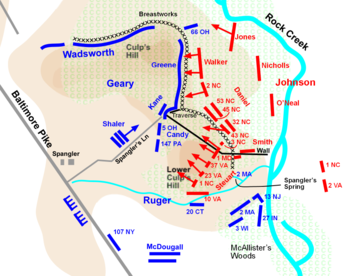
Since the fighting had stopped the previous night, the XI Corps units had been reinforced by additional troops from the I Corps and VI Corps
VI Corps (ACW)
The VI Corps was a corps of the Union Army during the American Civil War.-Formation:The corps was organized as the Sixth Provisional Corps on May 18, 1862, by uniting Maj. Gen. William B. Franklin's Division, which had just arrived on the Virginia Peninsula, with Maj. Gen. William F. Smith's...
. Ewell had reinforced Johnson with additional brigades from the division of Maj. Gen. Robert E. Rodes
Robert E. Rodes
Robert Emmett Rodes was a railroad civil engineer and a promising young Confederate general in the American Civil War, killed in battle in the Shenandoah Valley.-Education, antebellum career:...
, under Brig. Gens. Junius Daniel
Junius Daniel
Junius Daniel was a planter and career military officer, serving in the United States Army, then in the Confederate States Army during the American Civil War, as a brigadier general. His troops were instrumental in the Confederates' success at the first day of the Battle of Gettysburg...
and William "Extra Billy" Smith and Col. Edward A. O'Neal. These additional forces were insufficient to deal with the strong Union defensive positions. Greene repeated a tactic he had used the previous evening: he rotated regiments in and out of the breastworks while they reloaded, enabling them to keep up a high rate of fire.
In the final of the three Confederate attacks, around 10 a.m., Walker's Stonewall Brigade and Daniel's North Carolina brigade assaulted Greene from the east, while Steuart's brigade advanced over the open field toward the main hill against the brigades of Candy and Kane, which did not have the advantage of strong breastworks to fight behind. Nevertheless, both attacks were beaten back with heavy losses. The attacks against the heights were again fruitless, and superior use of artillery on the open fields to the south made the difference there.
The 1st Maryland Potomac Home Brigade
1st Maryland Infantry, Potomac Home Brigade
The 1st Maryland Infantry, Potomac Home Brigade was an infantry regiment that served in the Union Army during the American Civil War.-Service:...
(despite its name, a regiment of inexperienced recruits) was badly shot up struggling for a stone wall crossing the open field parallel to the line of works. Geary replaced them with the 147th Pennsylvania of Candy's brigade, which charged successfully, giving the field the name "Pardee Field" after the Pennsylvanians' Lt. Col. Ario Pardee, Jr.
The end of the fighting came near noon, with a futile attack by two Union regiments near Spangler's Spring. General Slocum, observing from the distant Powers Hill, believing that the Confederates were faltering, ordered Ruger to retake the works they had captured. Ruger passed the order to Silas Colgrove's brigade, and it was misinterpreted to mean a direct frontal assault on the Confederate position. The two regiments selected for the assault, the 2nd Massachusetts and the 27th Indiana, consisted of a total of 650 men against the 1,000 Confederates behind the works with 100 yards of open field in front. When Lt. Col. Charles Mudge of the 2nd Massachusetts heard the order he insisted that the officer repeat it. He was then quoted as saying "Well, it is murder, but it's the order." The two regiments attacked in sequence with the Massachusetts men in front, and they were both repelled with terrific losses: 43% of the Massachusetts soldiers, 32% of the Indianans. General Ruger spoke of the misconstrued order as "one of those unfortunate occurrences that will happen in the excitement of battle."
Despite receiving reinforcements and attempting his assaults again, Johnson was repulsed with terrible losses from one end of his line to the other. Colonel O'Neal wrote that his brigade "charged time and again up to their works but were every time compelled to retire. Many gallant men were lost." The losses at Culp's Hill included approximately 2,000 men in Johnson's division, nearly a third. An additional 800 fell from the reinforcing brigades on July 3. The XII corps lost about 1,000 men over both days, including 300 men in Greene's brigade, or one fifth. Alpheus Williams summed up the futility of this fighting: "The wonder is that the rebels persisted so long in an attempt that the first half hour must have told them was useless."
One of the sad stories of the war involved the Culp family. Two of Henry Culp's nephews were brothers: John Wesley Culp and William Culp. Wesley joined the Confederate States Army
Confederate States Army
The Confederate States Army was the army of the Confederate States of America while the Confederacy existed during the American Civil War. On February 8, 1861, delegates from the seven Deep South states which had already declared their secession from the United States of America adopted the...
and William the Union Army
Union Army
The Union Army was the land force that fought for the Union during the American Civil War. It was also known as the Federal Army, the U.S. Army, the Northern Army and the National Army...
. Wesley's regiment, the 2nd Virginia Infantry
2nd Virginia Infantry
The 2nd Virginia Volunteer Infantry Regiment was an infantry regiment raised in today’s West Virginia for service in the Confederate States Army during the American Civil War. It fought as part of the Stonewall Brigade, mostly with the Army of Northern Virginia....
, fought at Culp's Hill, and he was killed in the fighting on his family property on July 3. Ironically, he allegedly was carrying a message from another soldier, just deceased, to "Ginnie" Wade
Jenny Wade
Mary Virginia "Ginnie" Wade , a seamstress, was the only Gettysburg civilian killed directly during the Battle of Gettysburg....
, the only civilian killed during the battle. (His brother William was not present at Gettysburg and survived the war.)
Aftermath
Culp's Hill became a prime tourist attraction after the battle. It was close to the town and, unlike most battles in open fields, it was heavily wooded and the extreme firepower took a very visible toll on the trees, some of which were completely sheared off. Geary's division alone on July 3 reported that they expended 227,000 rounds. It took over twenty years before the scars of battle faded and nature reclaimed the breastworks.Today, Culp's Hill is unoccupied except for numerous monuments and an observation tower, all maintained by the U.S. National Park Service as part of the Gettysburg National Military Park
Gettysburg Battlefield
The Gettysburg Battlefield is the area of the July 1–3, 1863, military engagements of the Battle of Gettysburg within and around the borough of Gettysburg, Pennsylvania. Locations of military engagements extend from the 4 acre site of the first shot & at on the west of the borough, to East...
.

